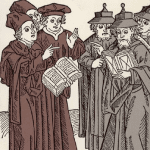The Impact of the Nuremberg Laws: A Turning Point in Antisemitism (1935)
Enacted on September 15, 1935, the Nuremberg Laws were a pivotal development in Nazi Germany, institutionalizing racism and laying the groundwork for the systematic persecution of Jews based on race, blood, and lineage. This represented a profound shift in antisemitic thinking and influenced antisemitic legislation across Europe.
Contents
The Nuremberg Laws comprised two main legislations: the Law for the Protection of German Blood and German Honour and the Reich Citizenship Law, which together, formed the basis for a series of oppressive measures against not only Jews but also other minority communities in Nazi Germany.
The Law for the Protection of German Blood and German Honour
This law prohibited marriages and extramarital intercourse between Jews and non-Jewish Germans, branding such relationships as “race defilement” (Rassenschande). It also barred Jews from employing young female German maids, reflecting the racial theories embodied by the Nazi regime.
The Reich Citizenship Law
This law restricted Reich citizenship to those of “German or kindred blood,” essentially depriving Jews and other minorities of their citizenship rights. It broadly defined Jews, including those who had converted to Christianity, leading to a widened scope of oppression. These laws were extended on November 26, 1935, to include Black people, Roma, and Sinti (Gypsies).
Mischlinge
The term Mischlinge referred to those who were neither categorized as German nor Jew and had 1-2 Jewish grandparents. Although they possessed rights comparable to “racial” Germans, subsequent legislation aimed to curtail these rights.
Significance
The Nuremberg Laws symbolize a turning point in the trajectory of antisemitism, pivoting from religious-based persecution to racial-based persecution. They laid the foundations for further discriminatory legislations across Europe and inspired similar laws in Italy, Hungary, Romania, Slovakia, Bulgaria, Vichy France, and Croatia by 1941.
“Race Pollution. Since 1923, Julius Streicher has enlightened the public about race pollution…What are the consequences of race pollution for the German maiden? What are the consequences of race pollution for the German Volk? The new Stuermer special issue.”
A Hitler Youth instructor teaching the definitions of race laid down by the Nuremberg Laws, September 1939.
Süddeutsche Zeitung Photo / Scherl, Munich

Discouraging German-Jewish Integration
In 1933, Jewish businessman Oskar Danker and his girlfriend, a Christian woman, were forced to carry signs discouraging Jewish-German integration. Intimate relationships between “true Germans” and Jews were outlawed by 1935.
CREDIT: akg-images / Pictures From History











